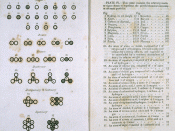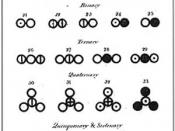The atomic theory has changed much since John Dalton's time. In the
late seventeen hundreds John Dalton first discovered that elements combine
in specific proportions because they are made of individual atoms. For
example, hydrogen and chlorine always combine in a specific proportion to
create hydrochloric acid. Dalton thought that atoms were small particles,
like a small marble. Dalton's atomic theory consisted of three parts. They
were:
*All substances are made of atoms. Atoms are small particles that cannot
be created, divided, or destroyed.
*Atoms of the same substance are exactly alike, atoms of different atoms
are different.
*Atoms join with other atoms of other substances to make new substances.
Dalton's theory was proved wrong when new information was discovered
and Dalton's theory could not explain it. The atomic theory has evolved.
In 1897, a scientist named J.J. Thompson found and identified a
problem in Dalton's theory. He discovered that there were particles inside
the atom.
So, Thompson said, atoms can be divided into even smaller parts.
The particles that were found inside the atom had a negative force. The
negatively charged particles were called electrons. Scientists had already
found out that atoms had no overall charge. Thompson didn't know the
location of the positively charged material so he made a theory that the
negatively charged electrons were embedded in the atom which was made
of overall positive matter. Thompson's model was called the plum-pudding
model. The electrons looked like plums that were in the pudding .
In 1909, a man named Ernest Rutheford, a former student of
Thompson wanted to investigate his former teacher's theory. He aimed a
small beam of radium particles at a sheet of thin gold foil. He thought if
atoms were only soft blobs embedded with electrons like Thompson had
suggested then the beam...



Comments
Your essay was decent; however, it left much to be desired. You could begin by finding common threads that strongly link the theories together, and providing some information on how the discovery was made along with scientific / mathematical reasoning. In addition, your conclusion left the whole topic open; whereas, it should have summed up your essay, without leaving questions about the topic itself hanging there. Though it should produce a desire to learn more about the topic within the reader, it should not leave questions that hold no merit (ie. how close are they to discovery?).
5 out of 8 people found this comment useful.